January 2025
Automotive Catalytic Converter Market (By Product: Two-Way Oxidation, Three-Way Oxidation-Reduction, Diesel Oxidation Catalyst; By Material: Platinum, Palladium, Rhodium) - Global Industry Analysis, Size, Share, Growth, Trends, Regional Outlook, and Forecast 2024-2034
The global automotive catalytic converter market size is expected to be worth USD 169.50 billion in 2024 and is projected to reach around USD 387.84 billion by 2034, expanding at a CAGR of 8.63% from 2024 to 2034. The rising inclination towards environmentally friendly mobility solutions drives the growth of the automotive catalytic converter market.
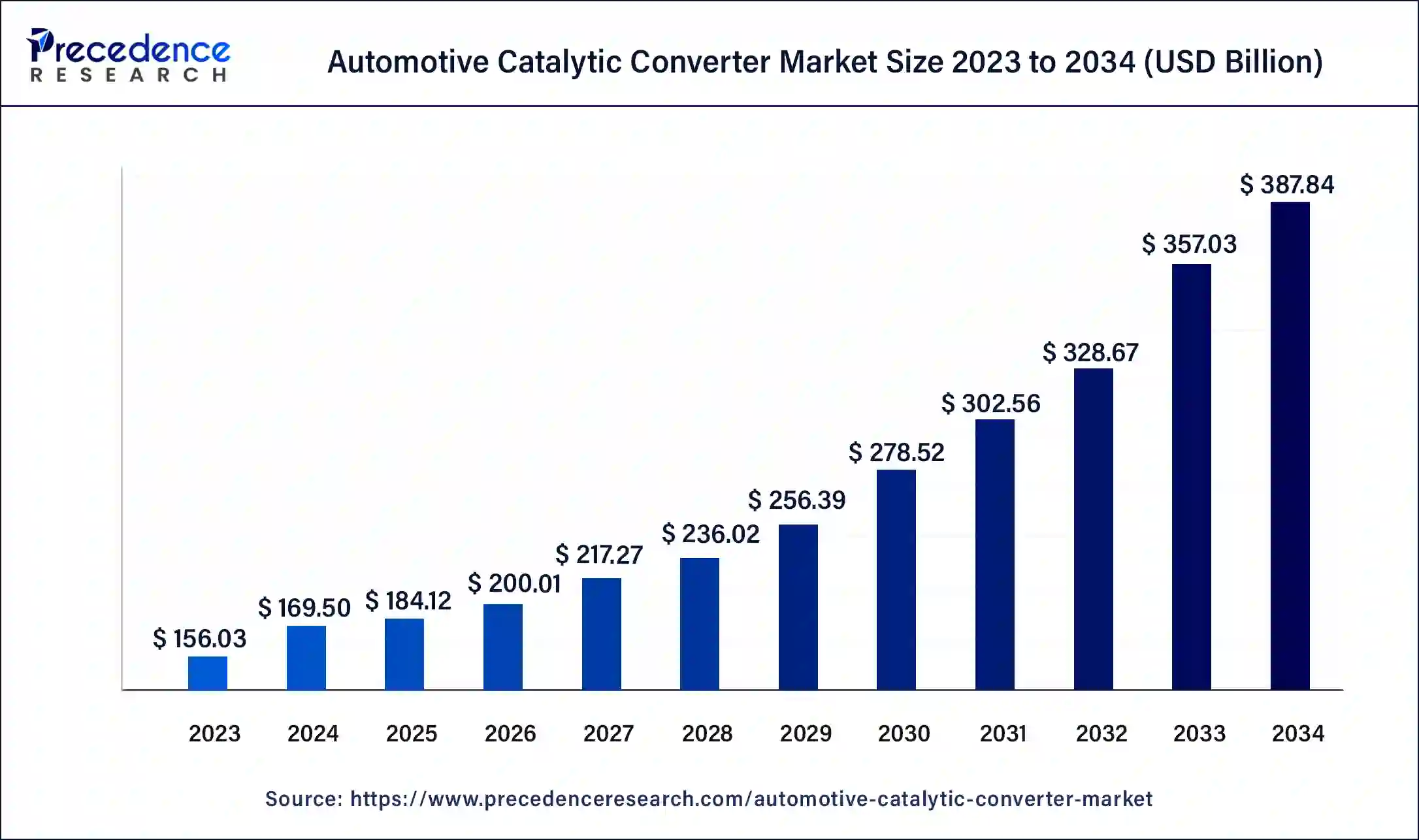
The Europe automotive catalytic converter market size was exhibited at USD 54.61 billion in 2023 and is projected to be worth around USD 137.68 billion by 2034, poised to grow at a CAGR of 8.77% from 2024 to 2034.
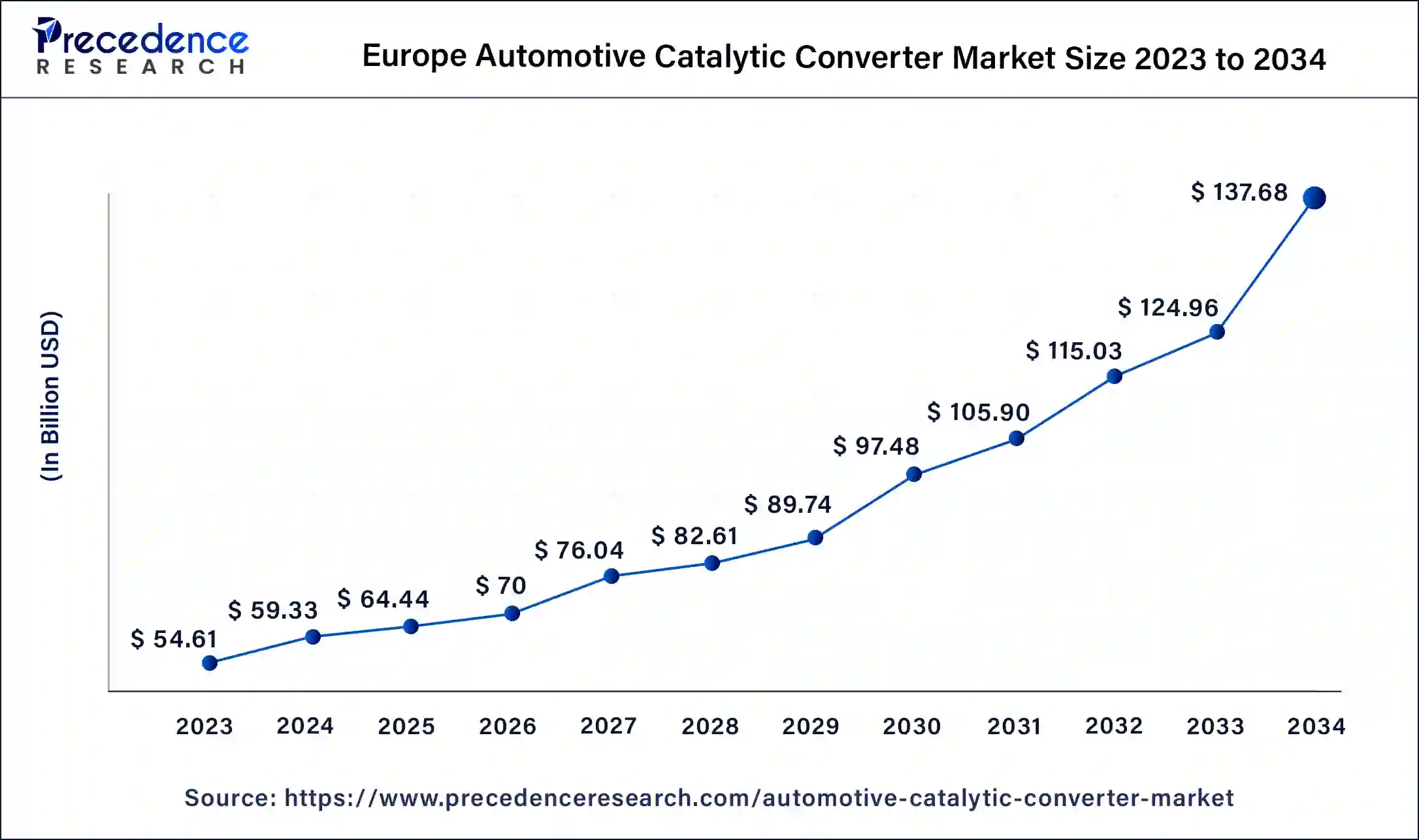
Europe dominated the market with the largest market share in 2023. The growth of the market in the region is attributed to the rising awareness about carbon emission in the environment by the rising number of automobiles on the road that is driving the demand for efficient technologies that help in reducing the carbon emission from vehicles, which boosts the growth of the automotive catalytic converter system. The rising government interventions for implementing supportive regulations for maintaining environmental safety are boosting the growth of the automotive catalytic converter system market across the region.
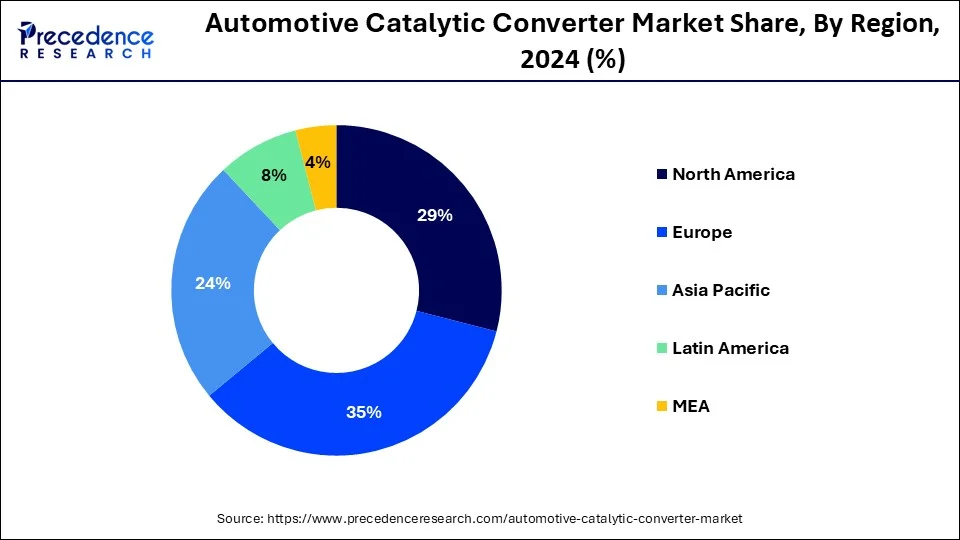
Asia Pacific is expected to have the fastest growth during the forecast period. The growth of the market in the region is attributed to the rising population of the regional countries, and the growing number of vehicles is causing a higher percentage of carbon emission in the environment that causes severe problems in the environment and human life, driving the demand for the catalytic converter system in the automobiles for maintaining and reducing the carbon emission is accelerating the growth of the automotive catalytic converter market in the region.
The catalytic converter is one of the essential parts of the automobile and the automobile manufacturing process. It plays a significant role in the vehicle’s exhaust system. The catalytic converter helps reduce the emission of harmful toxic pollution into the environment and converts it into substances like carbon dioxide and water vapors. The catalytic converter exposes harmful fumes to the metals and chemicals inside the converter for chemical reactions, which helps them transform harmful gases into substances like water vapors and carbon dioxide.
It is an essential component in the automobile that helps convert harmful gases into less harmful substances before releasing them into the environment or air. There are two main types of automotive catalytic converters: two- and three-way catalytic converters. The catalytic converter is made from some specific types of metal like palladium, platinum, or rhodium. The catalytic converter plays an important role in enhancing and maintaining the performance of vehicles and helps reduce atmospheric pollution. It makes the automobile more environmentally friendly. Thus, the rising concern about the environment and human health due to rising environmental pollution drives the growth of the automotive catalytic converter market.
| Report Coverage | Details |
| Market Size by 2034 | USD 387.84 Billion |
| Market Size in 2023 | USD 156.03 Billion |
| Market Size in 2024 | USD 169.50 Billion |
| Market Growth Rate from 2024 to 2034 | CAGR of 8.63% |
| Largest Market | Europe |
| Base Year | 2023 |
| Forecast Period | 2024 to 2034 |
| Segments Covered | Product, Material, and Regions |
| Regions Covered | North America, Europe, Asia-Pacific, Latin America, and Middle East & Africa |
Rising environmental and human health concerns
The growing population and the rising number of vehicles on the road are among the major reasons for carbon emissions and other harmful gases in the environment that have a severe impact on human health and the environment. Heavy environmental pollution causes severe health impacts, as it is the major cause of chronic diseases such as skin diseases, asthma, bronchitis, and other respiratory diseases.
The continuous rise in global warming due to vehicles emitting carbon into the environment drives the adoption of catalytic converters in automobiles. Additionally, the increasingly stringent regulation for limiting the vehicle population is forcing automobile manufacturers to adopt the catalytic converter to reduce carbon emissions from vehicles, which is also contributing to the growth of the automotive catalytic converter market.
The rising demand for catalytic converters from diesel-based vehicles is propelling the growth of the market. Diesel-based vehicles emit harmful gases in the environment, such as NOx and CO2 particles. Two types of catalytic converters are in higher demand from diesel vehicle manufacturers, including Lean NOx-Trap (LNT) and Selective Catalytic Reduction (SCR).
Rising adoption of EV (electric vehicles)
Rising environmental pollution and the increasing trend towards electric vehicle batteries are limiting the adoption of catalytic converters, and the increasing number of industry leaders shifting towards the manufacturing of battery electric vehicles is restraining the growth of the automotive catalytic converter market.
Rising competition in the automobile industry
The rising competition among automobile manufacturers globally is driving the opportunity for growth in the automotive catalytic converter market. The rising investment in technological advancements in the automobile and the catalytic converter development is accelerating the demand for the market. Additionally, the rising partnership between the component manufacturer and vehicle manufacturer is driving the growth of the market. The increasing consumer awareness about environmental pollution tends to the higher demand for vehicles that generate less pollution, which boosts the growth of the adoption of the catalytic converter by the major industry leaders, which is fueling the growth of the market.
The three-way oxidation-reduction segment dominated the automotive catalytic converter market in 2023. The growth of the segment is attributed to the higher capacity of emission control, which drives the adoption of the three-way oxidation-reduction segment. The three-way oxidation-reduction is the main technology in the automotive catalytic converter to control carbon emissions such as gasoline, liquefied petroleum gas (LPG), and natural gas in the environment that causes severe negative impacts on the human body.
The three-way oxidation-reduction catalytic used the closed-loop system, including oxygen sensors and lambda, for regulating the airflow into the gasoline engine. The catalyst uses metallic or ceramic substances with an active coating, including ceria, alumina, and other oxide combination metals like palladium, platinum, and rhodium.
The two-way oxidation segment is expected to grow fastest during the forecast period. The rising adoption of gasoline-powered vehicles is driving the demand for two-way oxidation catalysts, which are cost-effective solutions for gasoline vehicles. The rising demand for gasoline vehicles in developing and developed countries due to the rising awareness about carbon emissions is driving the demand for the segment in the automotive catalytic converter market.
The palladium segment captured the largest market share in 2023. The growth of the segment is attributed to the rising adoption of the palladium catalytic converter due to its increased capacity to minimize the harmful emissions from petroleum engine vehicles. The increasing demand for the palladium catalytic converter from the automobile industry.
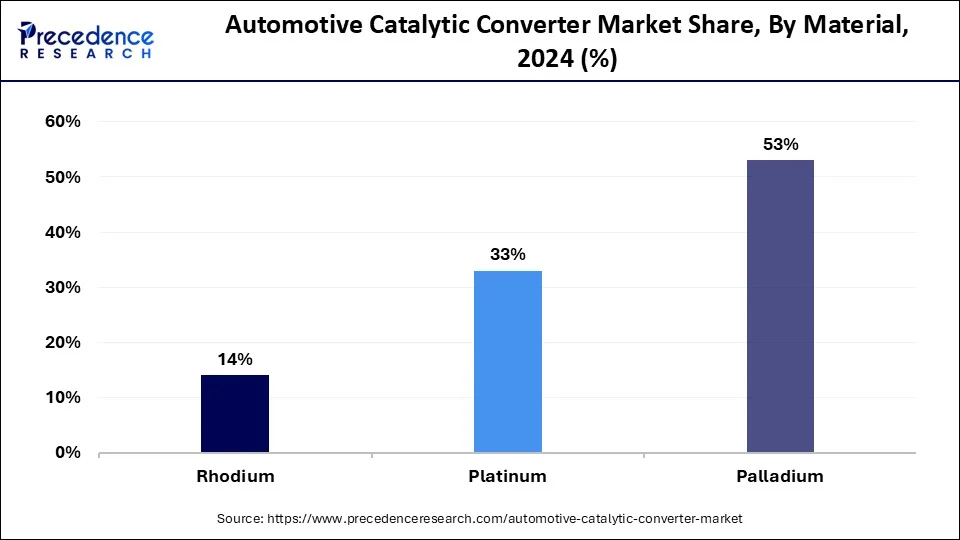
The palladium plays an important role in the automobile industry. Palladium is highly capable of neutralizing toxic pollutants by turning them into water vapor and carbon dioxide. The major portion of palladium is used by the automotive industry for the manufacturing of catalytic converters to reduce carbon monoxide, hydrocarbons, and other harmful gases from exhaust emissions.
The platinum segment is expected to grow significantly in the market during the anticipated period. The increasing demand for the platinum catalytic converter from the automobile industry due to its good oxidation catalyst and higher resistance to phosphorus, sulfur, and lead.
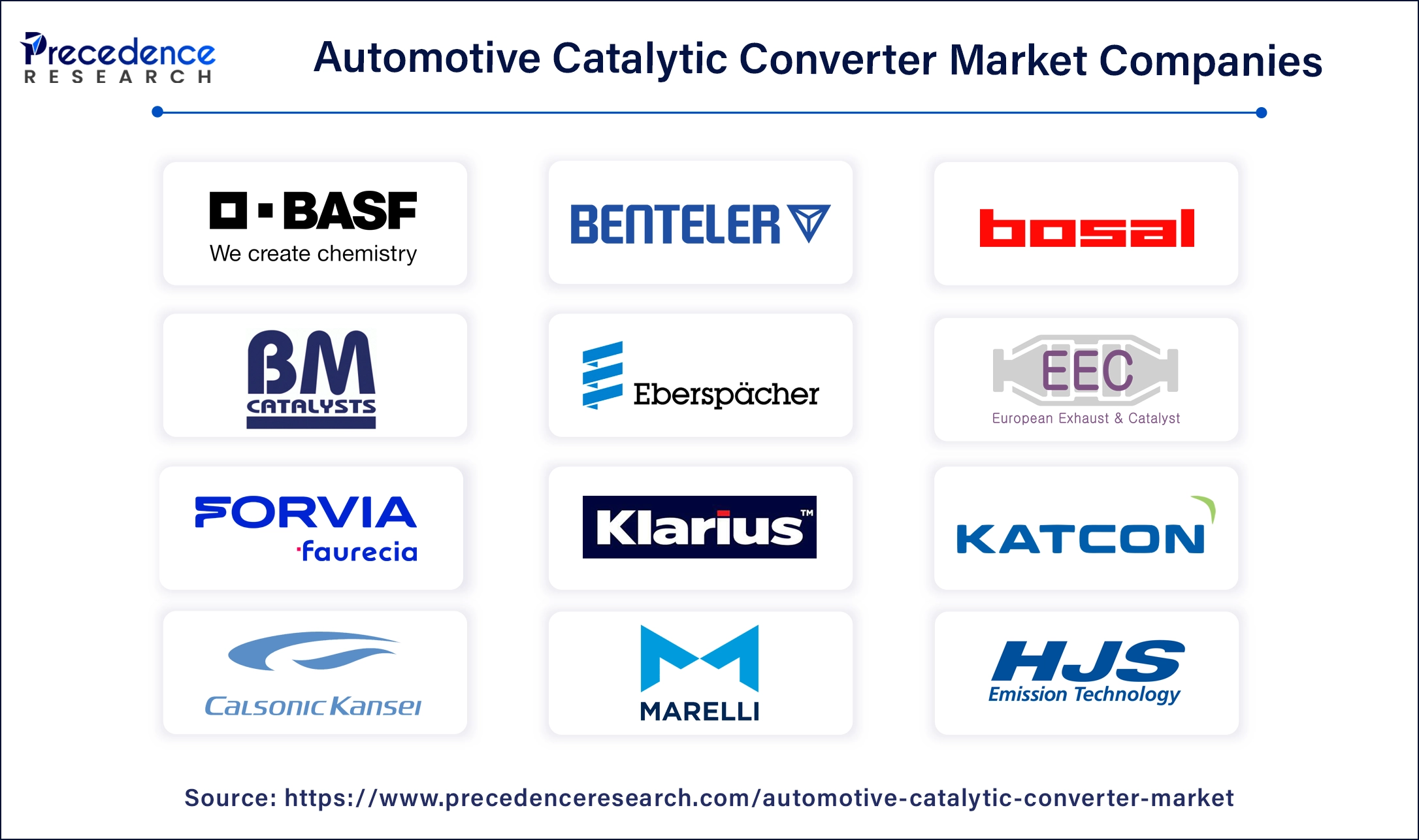
Segments Covered in the Report
By Product
By Material
By Geography
For inquiries regarding discounts, bulk purchases, or customization requests, please contact us at sales@precedenceresearch.com
No cookie-cutter, only authentic analysis – take the 1st step to become a Precedence Research client
January 2025
April 2025
April 2025
January 2025